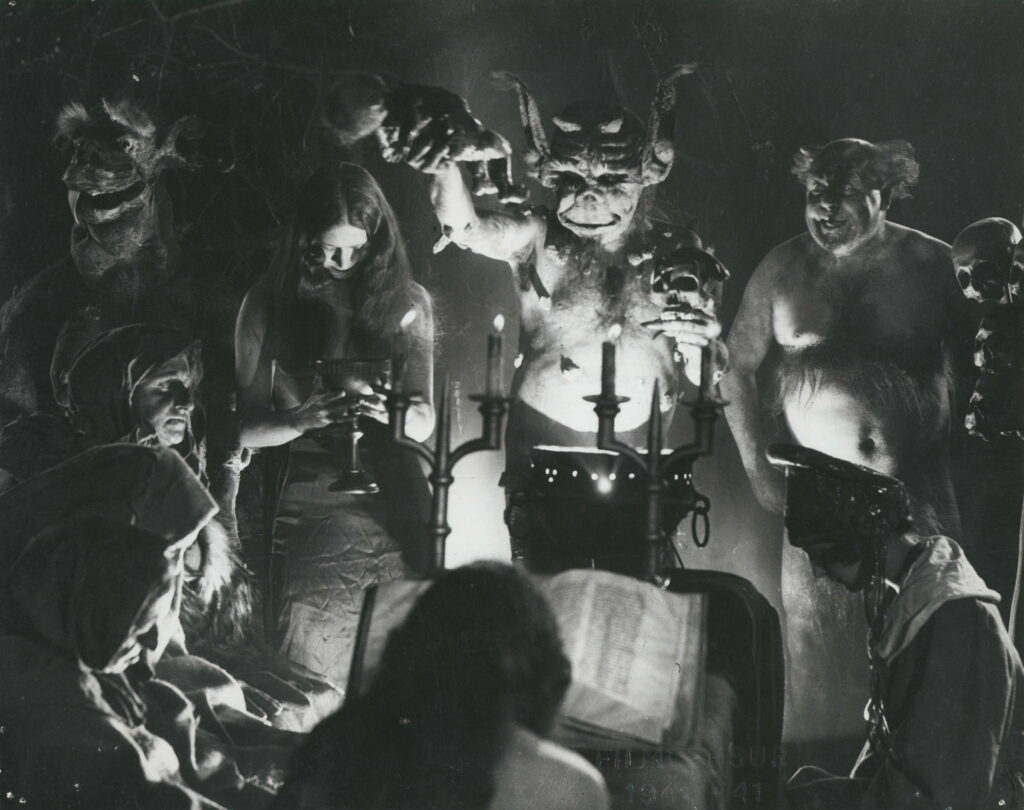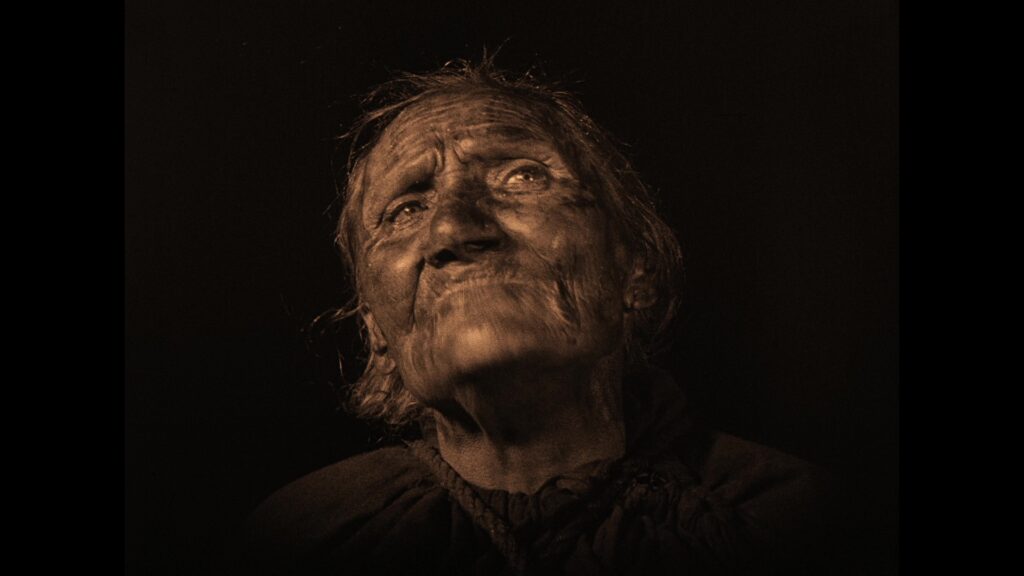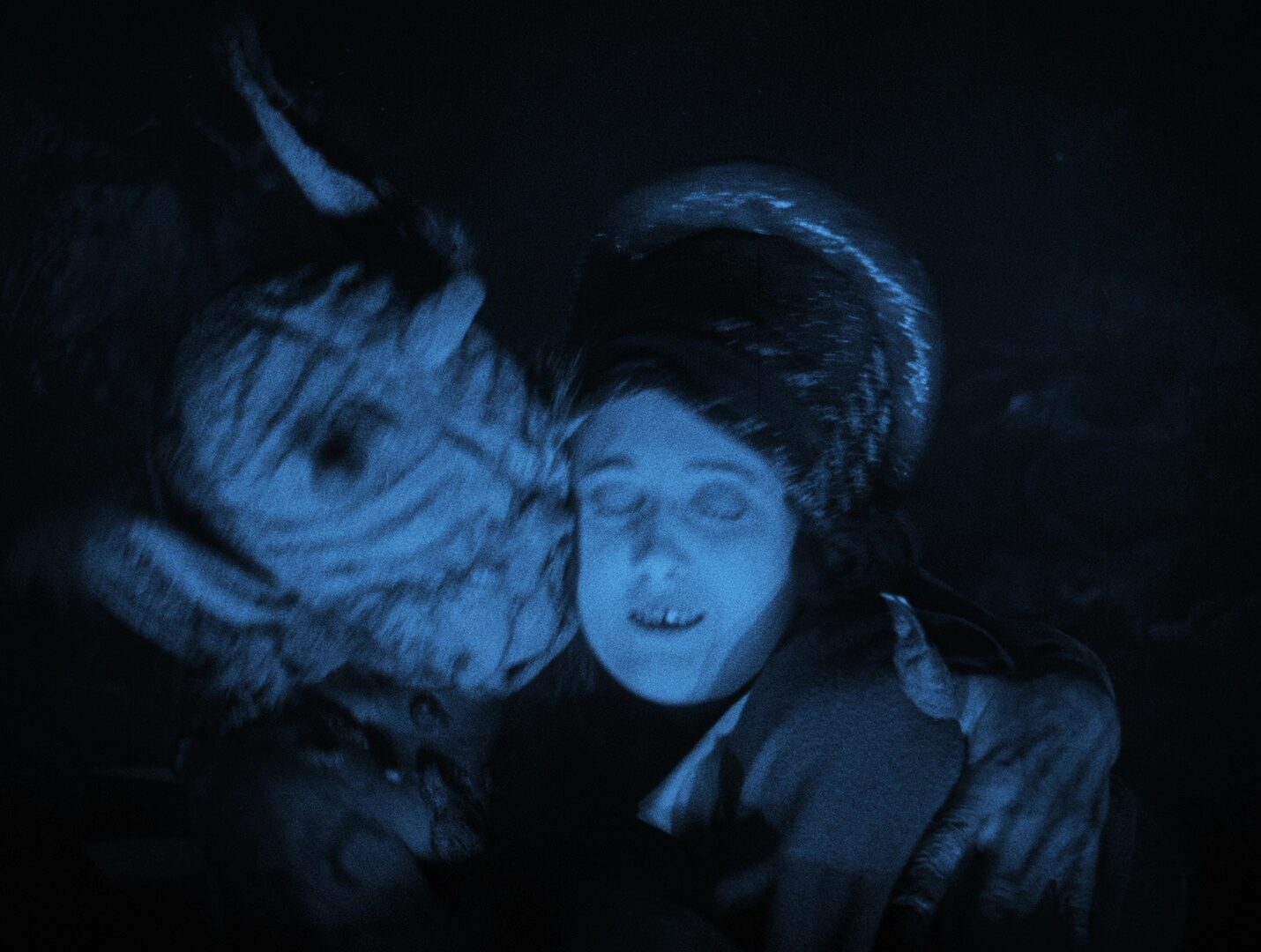Please allow me to play devil’s advocate for the silent film Häxan (aka The Witch, subtitled “A cultural and historical presentation in moving pictures in seven parts”). It was a Swedish silent film production released in 1922 and was written and directed by Danish film visionary Benjamin Christensen between 1919 -1921. It is generally considered the be among the first – if not the first – documentary film and the first known example of an exploitation film (per Wikipedia: an exploitation film is a film that tries to succeed financially by exploiting current trends, niche genres, or lurid content. Exploitation films are generally low-quality “B movies”, though some set trends, attract critical attention, become historically important, and even gain a cult following.)
The film is structured episodically and, after a brief historical overview, sequences a handful of scenarios that depict both fantastical descriptions of the witches’ world and others told in a more factual but no less intense manner regarding the persecution of those accused of being witches. Both kinds were written by Christensen based on actual historic records, including the testimony of accused witches. Most of the people who are familar with the film know it’s shorter version that was available in the heyday of VHS rentals. It had added narration by William S. Burroughs (a bonus, albeit an an unnecessary one for a silent film) and a completely inapropriate jazz-flavored soundtrack featuring a young Jean-Luc Ponty. The subsequent release of a high definition version – complete and with a score built on actual cues – was a revelation.
One of the beautiful things about silent films is that they were the birth of cinema and their legacy still influences film making today. From the editing techniques of the Russians, the Expressionist sets of the Germans, the love of chiffhanging serials from the French, and peak slapstick comedy from the US, the roots of cinema were planted and they still bear fruit today. In those early days in the ’10’s and ’20’s women were better represented and the industry was more fluid, less codified, with many film makers becoming mutidisciplinary ones by necessity, and a sizable number of directors crafting their films with no precedents to copy. The industry of filmmaking was born making it up as it went along, in that precious space before the audience’s erpeatedly stated preferences and business concerns reigned them in.
In this sense, Häxan is unique and once done, could only be copied; however, so particular was Christensen’s intent that I don’t think anything like it will reappear. Many of attributes of silent films that put off modern audiences are lessened or outright elimated in Häxan. There is no single story arc, nor any one that is overly dependent on dialogue, and the editing is tight, so that the pace stays energetic and the viewers’ attention constantly re-engaged. Christensen’s technique is often sophisticated: from stop-motion animation, to overwrought and disturbing sets and lighting, from still frightening make-up and scenes of horror, and a deft direction that elicits performances from the powerfully sincere to the most stagey. The cleverest part of the script is the use of witches’ testimony and the literal portrayal of the same, no matter how fantastical or supernatural, and the casting of of people who were not usually actors. I believe it’s this aspect that earns the film the title of first exploitation film, the fact that it is presented as historical and anecdotal no matter how prurient or disturbing the content.
Häxan was provocative and if you haven’t seen the film, it still has the power to provoke. Rather than attempt to list my favorite and most striking images from it, let me share this trivia from IMDb about scenes that were cut in 1922:
“The Swedish film censors required numerous cuts in the film, before authorizing its release. Among the censored scenes were the closeup of the finger being removed from the hanged man’s hand, the trampling of the cross in the witch’s sabbath scene, the shot of the oozing infant held over a cooking pot, a closeup of a woman’s face while she is on a torture rack, closeups of several instruments of torture being employed, and a shot of a demon embracing a nude woman (all these shots have since been restored to the film).”

As iconic as these scenes are, I think they are a distraction for the other half of the film, something I consider the heart of Benjamin Christensen’s intent: to show women “suffering” from hysteria being persecuted unjustly and how that oppression can cascade to rope in all manner of innocents. Although there is a sequence involving women actually practicing as witches, it’s not romanticized, and they seem like older, poor women eking out an existence, selling curses and cures for coins. The many scenes that describe instruments of torture, while also appealing to their sensational nature, are undeniably presented as an evil inflicted on the innocent.
There are two scenes, inked in the narrative but distinct in the film, that I will describe that I believe show Christensen’s point(s) best:
The first scene involves the interrogation of an old, haggish witch by the Inquisition. She looks and acts like an scared older woman while her interrogators are bullies intent on finding her guity and using her as kindling. The stark brutality of these black-and-white scenes set the precedent for films like Witchhammer and even Dreyer’s classic La Passion de Jeanne d’Arc (a French production of that fellow Danish director’s work in 1928). For Benjamin Christensen to flip the script, to make the Devil our own brothers, was a pretty radical stance even if obviously true historically. Up until the 1960’s, similiar opinions espoused by psychiatrist Thomas Szasz (“In the past, men created witches: now they create mental patients.”) were still considered on the fringe.

As one would expect, the accused succumbs to the pains of torture and ends up roping in others who she feels have wronged her by accusing them of also practicing the dark arts. The more they torture or threaten to continue torturing her, the more victims she offers them.
The second scene involves the arrest of the accused witches and, as things go from bad to worse, any number of women in the vicinity. It is the horror of this oppression, culturally- and religiously-approved and state sanctioned, that crushes the viewer witth its hopelessness. Christensen’s message is clear: being a woman at that time was an often prematurely fatal condition.
I like to think that the overwrought elements of the film allow Christensen to make an otherwise subversive point palatable to a still patriarchial audience, a sort of sleight-of-hand where showing a lovely ass allows you to publicly bemoan the treatment of women. Although it’s possible he just liked both things without my ascribed intent, it would have definitely been much simpler to deal in stereotypes and make a lesser, ridiculous film full of pandering, like some Goth Méliès, where the Devil is a jack-in-the-box and imps kep appearing and disappearing.
No matter your beliefs, whether Satan is real or theoretical or fictional, we can all agree that women have gotten a raw deal in general, and being persecuted as witches in particular. Dr. Szasz contended that a function of society is to scapegoat and even though we now agree witches don’t exist, have we just come up with a new label for another group? The timeless appeal of Häxan is its gonzo, birth-of-cinema, wrapped-in-spooky handling of this question. It made a stir at the time of its release and still has the power to amaze a hundred years later. I think you should see it.
Thank you.

Leave a Reply
You must be logged in to post a comment.